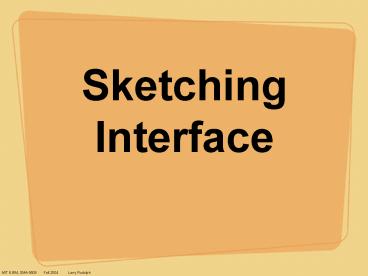Sketching Interface - PowerPoint PPT Presentation
1 / 33
Title: Sketching Interface
1
Sketching Interface
2
Motivation
- Natural Interface
- touch screens more
- Mass-market of h/w devices available
- Still lack of s/w applications for it
- Similar and different from speech
- how?
3
Comparison to speech
- Noisy environment -- can write but cannot talk
- Sketches useful after communication is over
- Can express things for which there are
- too many words
- no words
- picture is worth at least 1,000 words
- Compare to GUI?
- GUI provides fixed, visible vocabulary
- sketching has invisible domain
- Sketching like speech relies on users familiarity
4
Perceptual User Interface (PUI)
- Vision, speech, gestures are come to mind
- Hey, dont forget sketching
- Sketching modes
- formal
- CAD tools
- informal
- ambiguity encourages the designer to explore more
ideas in early stages - ignore details such as color, alignment, size
- both?
- do not to do both from scratch. when ready, fix
up informal sketch
5
Differences in strategies
- Recognize vs. Dont recognize
- Similar to speech trade-offs
- word recognition
- sentence (concept) recognition
- When is recognition done?
- stroke-based (while drawing)
- image-based (after drawing is done)
6
Why no recognition
- actually, a spectrum of recognition
- quickly prototyping user interfaces
- easier than using CAD tools
- easier to brainstorm be creative
- what to do with recognition errors?
- separate window?
- nothing do not want to interfere?
7
Some projects
- Assist (Davis -- MIT / CSAIL)
- more about this later
- Silk (Landay and Myers 2001)
- Sketching Interfaces Like Krazy
- more in next slildes
- some others not discussed
- Burlap (Mankoff, Hudson 2000)
- mediation used to correct recognition errors
- DENIM (Lin, Newman 2000)
- sketch tool for web designers
- minimize the amount of recognition
8
Real-time Recognition
- Start with visual language
- syntax in a declarative grammar
- consider multiple ambiguous interpretations
- use probability to disambiguate
9
How Silk Works
- As designer sketches, silk recognizes them
- Assumed to use touch-screen
- Add behavior through storyboarding
- drawing arrows between related screens
- SILK transforms rough design to real one
10
Silk for Web Design
- Designer sketches UI (for web)
11
(No Transcript)
12
(No Transcript)
13
SILKs Editing Gestures
- Recognizes gestures through Rubines algorithm
- statistical pattern-recognition trains
classifiers - used only 15 to 20 examples for each primitive
- To classify gesture, compute its distinguishing
f. - angles, point-to-point distances
14
Lots of ambiguities
- Attachment
- text to line
- Gap
- omitted values
- Role
- what is legend?
- Segmentation
- single terminal represents multiple syntactic
entities - Occlusion
15
Very similar to Galaxy
16
Visual Language Syntax
17
Probability to the rescue
- To give a label to an element in drawing, base it
one multiple features - Use Bayes Theorem
- prob this is the label given these features
- probability given this label, would have these
features - accounting for the likelihood of these features
here
18
Fixup the description
19
A parse in action
20
Domain dependent
- Like speech, good results require limiting of the
domain - Accuracy not very good a couple of years ago
- Must do more analysis in each domain
21
MIT Assists Approach
- Interprets and understands as being drawn
- sequence of strokes while system watches
- Very limited domain -- mechanical engineering
- general architecture to
- represent ambiguities
- add contextual knowledge to resolve ambiguities
- low-level --- purely geometric
- high-level -- domain specific
22
More detail
- delay commitment -- until body is done
- timing is crucial
- too early, not enough information
- too late, not useful to user
- people tend to draw all of one object before
moving to a new one - longer figure remains unchanged, more likely new
strokes will not be added
23
General strategies
- Simpler is better
- more specific is better
- user feedback
- single stroke rather than bunch of parts
- rule based system
- not virturbi-like search
24
Early Processing
- Find line segments
- so find the vertices
- not so easy
- wrong geometry
- round corners
25
direction, curvature speed
- Find places with
- minimum speed
- maximal curvature
26
One is not enough
- Use average based filtering
- divide into regions of max curvature and min
speed - curvature speed not uniform
- different approx on each
- combined is best
27
Description of shapes
- Built-in, basic shapes fine, but limited
- Want hierarchical, composible shapes
- One approach
- constrained rule-based
- 2-d is harder than 1-d, so constrains work better
- language for describing shape
28
Domain Description in Ladder
29
(No Transcript)
30
Some basic shapes that have been defined
31
Sketching Flowcharts
32
PADCAMA human-centric sketching user interface
33
PADCAMA human-centric sketching user interface
- Use any pen
- Use any paper
- Draw as usual
- Strokes captured with timing info
- as if done on touch screen
- If system crashes, still have notes

